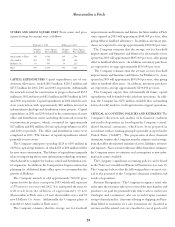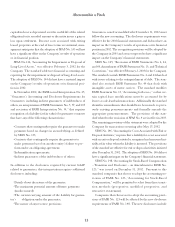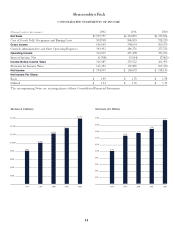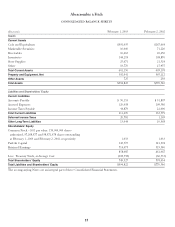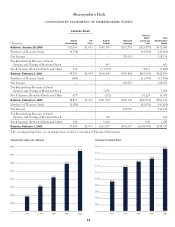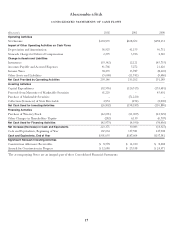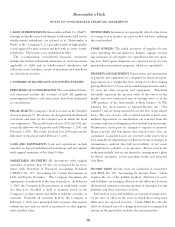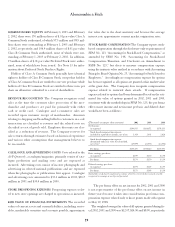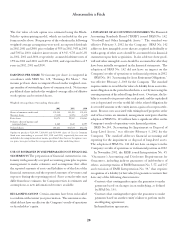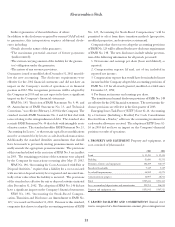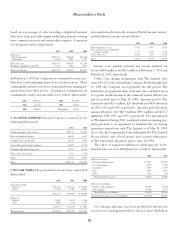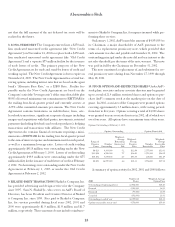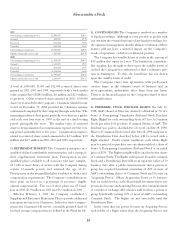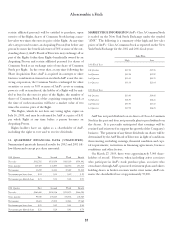Abercrombie & Fitch 2002 Annual Report Download - page 23
Download and view the complete annual report
Please find page 23 of the 2002 Abercrombie & Fitch annual report below. You can navigate through the pages in the report by either clicking on the pages listed below, or by using the keyword search tool below to find specific information within the annual report.
Abercrombie &Fitch
The fair value of each option was estimated using the Black-
Scholes option-pricing model, which are included in the pro
forma results above. For purposes of the valuation the following
weighted-average assumptions were used: no expected dividends
in 2002, 2001 and 2000; price volatility of 53% in 2002, 54% in 2001
and 50% in 2000; risk-free interest rates of 4.3%, 4.7% and 6.2%
in 2002, 2001 and 2000, respectively; assumed forfeiture rates of
15% in 2002 and 2001 and 10% in 2000; and expected lives of 5
years in 2002, 2001 and 2000.
EARNINGS PER SHARE Net income per share is computed in
accordance with SFAS No. 128, “Earnings Per Share.” Net
income per basic share is computed based on the weighted–aver-
age number of outstanding shares of common stock. Net income
per diluted share includes the weighted–average effect of dilutive
stock options and restricted shares.
Weighted–Average Shares Outstanding (thousands):
2002 2001 2000
Shares of common stock issued 103,300 103,300 103,300
Treasury shares (5,128) (4,198) (3,239)
Basic shares 98,171 99,102 100,061
Dilutive effect of options and
restricted shares 2,460 3,422 2,095
Diluted shares 100,631 102,524 102,156
Options to purchase 9,218,000, 5,630,000 and 9,100,000 shares of Class A Common
Stock were outstanding at year-end 2002, 2001 and 2000, respectively, but were not
included in the computation of net income per diluted share because the options’ exer-
cise prices were greater than the average market price of the underlying shares.
USE OF ESTIMATES IN THE PREPARATION OF FINANCIAL
STATEMENTS The preparation of financial statements in con-
formity with generally accepted accounting principles requires
management to make estimates and assumptions that affect
the reported amounts of assets and liabilities as of the date of the
financial statements and the reported amounts of revenues and
expenses during the reporting period. Since actual results may
differ from those estimates, the Company revises its estimates and
assumptions as new information becomes available.
RECLASSIFICATIONS Certain amounts have been reclassified
to conform with current year presentation. The amounts reclas-
sified did not have an effect on the Company’s results of operations
or shareholders’ equity.
3. ISSUANCES OF ACCOUNTING STANDARDS The Financial
Accounting Standards Board (“FASB”) issued SFAS No. 142,
“Goodwill and Other Intangible Assets.” The standard was
effective February 3, 2002 for the Company. SFAS No. 142
addresses how intangible assets that are acquired individually or
with a group of other assets should be accounted for in financial
statements upon their acquisition. It also addresses how good-
will and other intangible assets should be accounted for after they
have been initially recognized in the financial statements. The
adoption of SFAS No. 142 did not have an impact on the
Company’s results of operations or its financial position in 2002.
SFAS No. 143, “Accounting for Asset Retirement Obligations,”
was effective February 2, 2003 for the Company. The standard
requires entities to record the fair value of a liability for an asset retire-
ment obligation in the period in which it is a cost by increasing the
carrying amount of the related long-lived asset. Over time, the lia-
bility is accreted to its present value each period, and the capitalized
cost is depreciated over the useful life of the related obligation for
its recorded amount or the entity incurs a gain or loss upon settle-
ment. Because costs associated with exiting leased properties at the
end of lease terms are minimal, management anticipates that the
adoption of SFAS No. 143 will not have a significant effect on the
Company’s results of operations or its financial position.
SFAS No.144, “Accounting for Impairment or Disposal of
Long-Lived Assets,” was effective February 3, 2002 for the
Company. The standard addresses financial accounting and
reporting for the impairment or disposal of long-lived assets.
The adoption of SFAS No. 144 did not have an impact on the
Company’s results of operations or its financial position in 2002.
In November 2002, the FASB issued Interpretation No. 45,
“Guarantor’s Accounting and Disclosure Requirements for
Guarantees, including indirect guarantees of indebtedness of
others, an interpretation of FASB Statements No. 5, 57, and 107
and rescission of FASB Interpretation No. 34,” that requires
recognition of a liability (at fair value) for guarantee contracts that
have any of the following characteristics:
■ Contracts that contingently require the guarantor to make
■payments based on changes in an underlying, as defined
by SFAS No. 133;
■ Contracts that contingently require the guarantor to make
■ payments based on another entity’s failure to perform under
■ an obligating agreement;
■Indemnification agreements;
20


